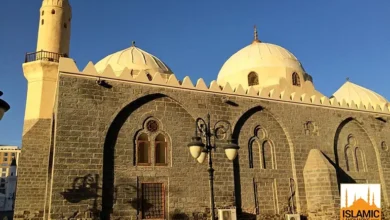
Saba Masajid, also known as the Seven Mosques, is a significant historical and religious site located in Madinah, Saudi Arabia. These mosques are associated with key events from Islamic history, particularly the Battle of the Trench (Ghazwa-e-Khandaq). They hold deep spiritual value for Muslims worldwide and are often included in Ziyarat (religious visits) by pilgrims during their stay in Madinah.
Historical Significance of Saba Masajid
The Seven Mosques are connected to the events of the Battle of the Trench, fought in 627 CE (5 AH). This battle was a pivotal moment in Islamic history when the Muslims of Madinah, under the leadership of Prophet Muhammad (PBUH), defended the city against a coalition of Quraysh and allied tribes.
The Role of the Trench
The Muslims dug a trench (Khandaq) around Madinah as a defensive strategy, inspired by the suggestion of Salman Al-Farsi (RA). The locations of these mosques correspond to areas where the trench was dug, and key events of the battle took place.
The Seven Mosques
- Masjid Al-Fath (Mosque of Victory):
- Located on a hilltop, this mosque marks the spot where Prophet Muhammad (PBUH) prayed for victory during the Battle of the Trench.
- It is the largest and most prominent of the Seven Mosques.
- Masjid Salman Al-Farsi:
- Named after the companion who suggested the trench strategy, this mosque commemorates his contribution to the Muslim defense.
- Masjid Abu Bakr:
- Associated with the first Caliph, Abu Bakr As-Siddiq (RA), who actively participated in the battle preparations.
- Masjid Umar:
- Named after the second Caliph, Umar ibn Al-Khattab (RA), this mosque highlights his role during the siege.
- Masjid Ali:
- Dedicated to Ali ibn Abi Talib (RA), the cousin and son-in-law of Prophet Muhammad (PBUH), known for his bravery in defending Madinah.
- Masjid Fatima (Masjid Sa’ad):
- Named after Fatima (RA), the daughter of Prophet Muhammad (PBUH), or Sa’ad ibn Muadh (RA), who played a key role in the battle.
- Masjid Qiblatain (sometimes considered part of Saba Masajid):
- Known as the Mosque of Two Qiblas, it is where the direction of prayer (Qibla) was changed from Jerusalem to the Kaaba in Makkah.
Modern Significance
Today, these mosques stand as monuments of faith, resilience, and unity. While some of the original structures have been rebuilt or renovated, their historical essence remains intact.
Visiting Saba Masajid
- Location:
These mosques are located in close proximity to each other in the western part of Madinah, near the site of the trench. - Accessibility:
Easily reachable by car or guided tours.
Tips for Visitors
- Understand the History:
Learn about the Battle of the Trench to fully appreciate the significance of these sites. - Respect the Sanctity:
Dress modestly and behave respectfully while visiting these mosques. - Plan Your Visit:
Early mornings or late afternoons are ideal for avoiding crowds and heat.
Conclusion
The Saba Masajid stands as a timeless testament to the Islamic principles of unity, faith, and resilience. For pilgrims and visitors in Madinah, exploring these mosques is a deeply enriching spiritual experience, offering a glimpse into the rich history of Islam.
Plan Your Ziyarat to Saba Masajid
Experience the historical and spiritual essence of Madinah with Yamama Travel and Tours. Let us guide your journey to Saba Masajid and other sacred sites for a fulfilling pilgrimage.
📞 Contact Us Today: Click Here



